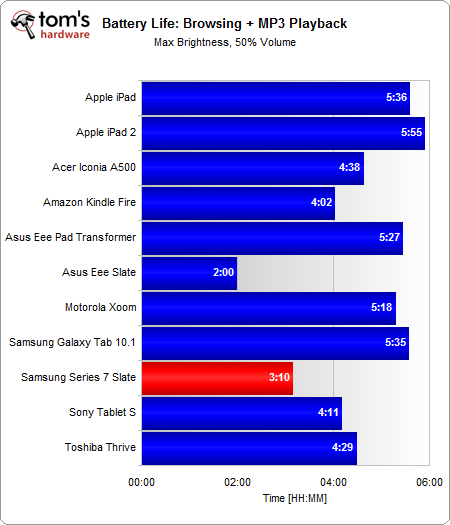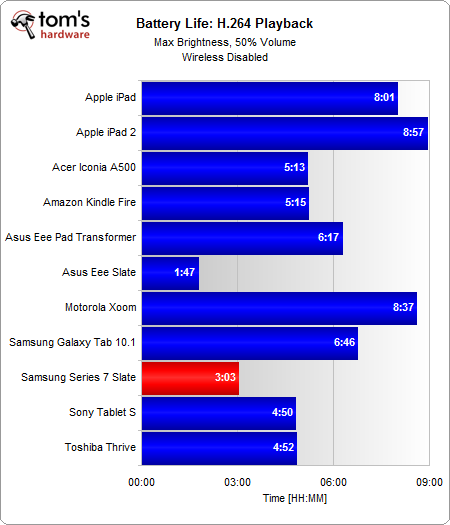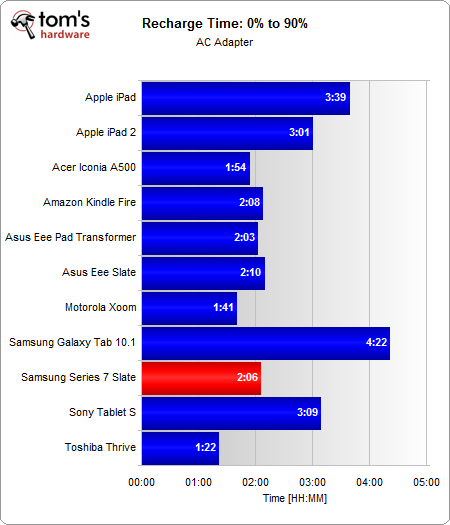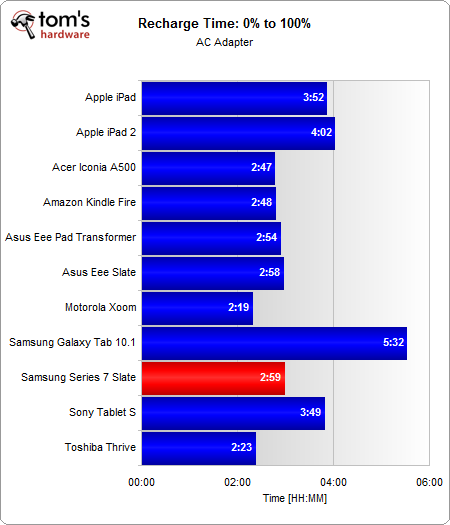Samsung Series 7 11.6" Slate: Breathing New Life Into Tablet PCs
Battery Life And Recharge Time
Our battery tests represent a worst-case scenario for all of these devices because we dial brightness up to each screen's maximum value. This is something you'll see evolve in 2012 to include battery life results indicative of a normalized screen brightness level.
For the time being, though, we put specific emphasis on display quality, and we want to show you what you end up with, mobility-wise, when you take advantage of the higher-end screens available on tablets and tablet PCs. The resulting scores are particularly hard on the slates based on x86 hardware. Because they consume significantly more power and are never allowed to sit idle, they generally don't compare favorably. The advantages of ARM's architecture is most apparent in this case.
Despite a battery test that we already know is stacked against both slates, Samsung's offering is vastly superior to Asus' here. Not only does it come equipped with an excellent display, but it also shoulders three hours of a relatively heavy workload before running out of juice. If you enable the ambient light sensor to auto-dim brightness, you can easily expect four to five hours of useful life. And that's what makes this tablet PC better suited to the daily grind as you jump from one meeting to the next.
Get Tom's Hardware's best news and in-depth reviews, straight to your inbox.
Current page: Battery Life And Recharge Time
Prev Page Real-World Performance Against Tablets Next Page Display Quality: Color Gamut-
g-unit1111 Do. Want. Finally - a tablet that doesn't require a proprietary operating system that needs 1,000,000,000 apps for every website on the internet in order to function properly. It has an SSD and not flash memory. It has a real working version of Windows - with a great interface on top of it. This looks like a tablet I can get behind.Reply -
A very nice tablet! Hoping that ivy bridge will allow faster processers without creating too much heat and saving battery. I'm really looking into getting a tablet in the future to replace my notebook and this looks is very reassuring that things are improving :P.Reply
-
What about the digitizer? I appreciate the comparisons to the Asus EEE Slate, but that has a 256-level pressure sensitive wacom digitizer on top of the screen. And no mention of it or what is on this device?Reply
-
joytech22 Yay finally, I saw this in shops around a month ago and wonder when tom's would cover it. :pReply -
Gamer-girl The UI makes it seem like a smartphone. You keep mentioning the pen but there is no comparison? Does it have palm rejection?Reply -
theuniquegamer Instead of current sandybridge (i.e hd 3000) the should give an amd llano which has a better gpu or the ivy bridge mobile cpus (which is with hd 4000 gpu) and a lower TDP.Reply -
alyoshka Isn't it a little steep for a 1000$....??? After all it's a Samsung, 11.6Inch Tab.......Reply
I think it'd be a lot more wiser to buy a laptop for that price and get a much more efficient and powerful piece of tech. -
alyoshka I would have given the Note from Samsung a thought had it had 7.5 installed on it..... but again..... it's a samsung.....Reply



